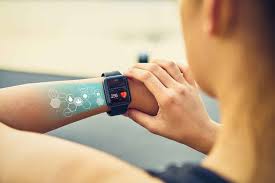Health Monitoring Wearables: The Future of Preventive Healthcare
In recent years, the healthcare industry has undergone a transformation with the integration of technology into patient care. One of the most exciting developments in this space is the rise of health monitoring wearables, devices designed to track a user’s health metrics in real time. These wearables are changing the way people engage with their health, shifting the focus from reactive to preventive healthcare. As health monitoring wearables become more sophisticated, they offer an unprecedented opportunity to identify health issues early, reduce healthcare costs, and promote overall well-being.
This article explores how health monitoring wearables are transforming preventive healthcare, their key benefits, the most advanced technologies driving their adoption, and the challenges they face.
1. The Rise of Health Monitoring Wearables
Wearables such as fitness trackers, smartwatches, and medical-grade monitoring devices have seen a surge in popularity over the past decade. From early pedometers to today’s sophisticated smartwatches equipped with advanced sensors, the development of wearable technology has revolutionized the way individuals monitor their health.
The demand for wearables is primarily driven by the growing awareness of personal health, the shift towards fitness and wellness, and the increasing need for continuous health monitoring among aging populations and those with chronic conditions. According to research, the global wearable technology market is expected to grow exponentially in the coming years, reaching $104.39 billion by 2027.
One of the key attractions of health monitoring wearables is their ability to empower individuals to take control of their health. By tracking vital signs like heart rate, blood oxygen levels, sleep patterns, and physical activity, wearables provide users with actionable data that can help them maintain healthier lifestyles and avoid health risks.
2. Preventive Healthcare: A Shift from Reactive to Proactive
Traditionally, healthcare has been largely reactive, with individuals seeking medical attention only after symptoms appear. However, this approach often leads to late-stage diagnoses, costly treatments, and suboptimal outcomes. Preventive healthcare aims to address these challenges by focusing on early detection, disease prevention, and health maintenance.
Health monitoring wearables are the perfect tools for facilitating preventive healthcare. By providing continuous data on health metrics, wearables can detect irregularities early, allowing for timely medical intervention before a condition becomes serious. For example, wearables equipped with electrocardiogram (ECG) sensors can identify abnormal heart rhythms, potentially alerting users to atrial fibrillation (AFib) before they even notice symptoms. Early detection of such conditions can significantly reduce the risk of severe health events like strokes or heart attacks.
Moreover, wearables promote preventive healthcare by encouraging healthy behaviors. Many devices include features such as step counts, workout tracking, and reminders to move, helping users stay active and avoid sedentary lifestyles—key factors in preventing chronic conditions like obesity, diabetes, and cardiovascular disease.
3. Key Features of Health Monitoring Wearables
The ability of wearables to transform preventive healthcare lies in their increasingly sophisticated features. Here are some of the most important capabilities that health monitoring wearables offer today:
- Heart Rate Monitoring: One of the most common features in wearables, heart rate monitoring helps users track their cardiovascular health. Wearables use optical sensors to measure the heart rate continuously or on demand, providing real-time feedback on heart function during physical activity or at rest.
- Sleep Tracking: Poor sleep is linked to numerous health issues, including obesity, diabetes, and cardiovascular disease. Wearables monitor sleep patterns by tracking movement and heart rate, providing insights into sleep quality and duration, and helping users make adjustments to improve their sleep hygiene.
- Blood Oxygen Saturation (SpO2) Monitoring: Many modern wearables come equipped with pulse oximeters that measure blood oxygen levels. This feature became particularly relevant during the COVID-19 pandemic, as low oxygen levels can indicate respiratory issues.
- Electrocardiogram (ECG): High-end wearables now feature ECG sensors that allow users to monitor their heart rhythm. This feature is crucial for detecting irregularities like AFib, which can lead to strokes if left untreated.
- Activity and Fitness Tracking: Wearables are known for their ability to monitor physical activity, such as steps taken, calories burned, and active minutes. They often offer personalized workout recommendations, helping users stay fit and reduce their risk of lifestyle-related diseases.
- Blood Pressure Monitoring: Some advanced wearables can measure blood pressure non-invasively, providing users with another key metric for managing their cardiovascular health. While not as accurate as medical-grade devices, wearable blood pressure monitors offer valuable insights into hypertension trends.
- Temperature Sensors: Body temperature is an essential indicator of health, and wearables with temperature sensors can detect early signs of fever, infection, or inflammation. Continuous monitoring of body temperature can also help in fertility tracking for women.
- Stress Monitoring: Wearables that measure heart rate variability (HRV) or electrodermal activity (EDA) can estimate stress levels, offering insights into mental health. Chronic stress is linked to various health problems, including heart disease and depression, making this feature valuable for preventive care.
4. The Role of AI in Health Monitoring Wearables
Artificial intelligence (AI) is playing a critical role in enhancing the capabilities of health monitoring wearables. AI algorithms analyze the vast amounts of data collected by wearables to provide personalized insights, detect trends, and even predict potential health issues.
For example, AI can help identify patterns in a user’s heart rate data that may indicate underlying health conditions such as arrhythmias or sleep apnea. By continuously analyzing the data, AI-powered wearables can alert users to irregularities that might otherwise go unnoticed. This not only enhances preventive care but also reduces the burden on healthcare providers by allowing patients to monitor themselves more effectively.
AI also enables predictive analytics in wearables, allowing for the early detection of potential health risks based on historical data. For instance, AI can predict the likelihood of a user developing hypertension or diabetes by analyzing their activity levels, diet, and family history, enabling users to take preventive measures before the condition worsens.
5. Improving Patient Outcomes Through Continuous Monitoring
One of the most significant advantages of health monitoring wearables is their ability to provide continuous, real-time data. Continuous monitoring allows for a more comprehensive view of a person’s health than the snapshot provided by occasional doctor visits. This is especially important for patients with chronic conditions such as diabetes, heart disease, or respiratory illnesses.
For example, individuals with diabetes can use continuous glucose monitors (CGMs) to track their blood sugar levels throughout the day. These devices provide immediate feedback on how diet, exercise, and medication affect glucose levels, enabling users to make more informed decisions about their care. Similarly, patients with heart disease can use wearables to track their heart rate and rhythm, reducing the risk of sudden cardiac events by identifying warning signs early.
Wearables also play a key role in post-surgical care and rehabilitation. After surgery, patients can use wearables to monitor their recovery progress, track mobility, and ensure they are meeting prescribed activity levels. Physicians can use this data to adjust treatment plans, improving recovery times and reducing the likelihood of complications.
6. Wearables and Remote Patient Monitoring
The COVID-19 pandemic has accelerated the adoption of telemedicine and remote patient monitoring (RPM), and wearables are a central part of this shift. With wearables, patients can share real-time health data with healthcare providers without needing to visit a clinic. This has significant implications for managing chronic conditions and improving access to care, particularly in rural or underserved areas.
For example, patients with hypertension can use wearables to monitor their blood pressure at home, with the data automatically sent to their healthcare provider for review. If the wearable detects concerning trends, such as consistently high blood pressure readings, the physician can intervene early, adjusting medications or recommending lifestyle changes.
Remote monitoring through wearables also reduces the need for frequent in-person visits, lowering healthcare costs and increasing convenience for patients. It also enables doctors to keep an eye on high-risk patients, improving outcomes through early interventions.
7. Challenges and Ethical Considerations
While health monitoring wearables offer enormous potential for preventive healthcare, they also face several challenges. One of the primary concerns is the accuracy and reliability of the data collected by consumer-grade wearables. Although devices like smartwatches are equipped with advanced sensors, they are not always as accurate as medical-grade equipment. This can lead to false positives or missed diagnoses, undermining trust in wearables as health tools.
Data privacy is another significant issue. Wearables collect vast amounts of sensitive health data, raising concerns about how this information is stored, shared, and protected. Users need assurances that their data is secure and not being exploited for commercial purposes without their consent.
Additionally, the growing reliance on wearables for health monitoring raises questions about healthcare accessibility. While wearables are becoming more affordable, there are still socioeconomic barriers to widespread adoption, particularly in low-income or developing regions.
8. The Future of Health Monitoring Wearables
Looking ahead, the future of health monitoring wearables is bright. As sensor technology improves and AI becomes more advanced, wearables will become even more powerful tools for preventive healthcare. We can expect more medical-grade devices that offer accurate, real-time insights into a wider range of health metrics, from blood pressure and glucose levels to respiratory function and mental health.
The integration of wearables with healthcare systems will also continue to grow, enabling seamless data sharing between patients and providers. This will lead to more personalized care plans and better health outcomes, particularly for individuals with chronic conditions.
Moreover, as wearable technology becomes more affordable and accessible, it has the potential to revolutionize global healthcare by promoting preventive care, reducing the burden on healthcare systems, and improving health outcomes across populations.
Conclusion
Health monitoring wearables represent a major shift in how healthcare is delivered, moving from reactive treatment to proactive prevention. With their ability to continuously monitor vital signs, detect health issues early, and encourage healthy behaviors
, wearables are playing an essential role in the future of preventive healthcare. As technology advances and wearables become more integrated into healthcare systems, they will undoubtedly contribute to a healthier and more empowered population.


